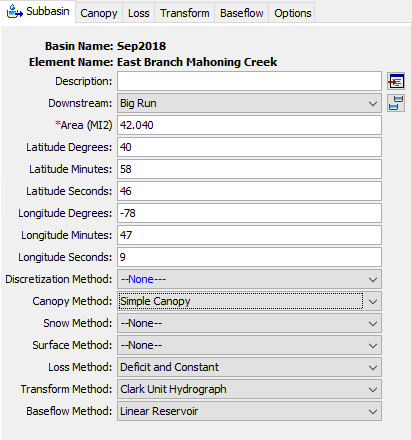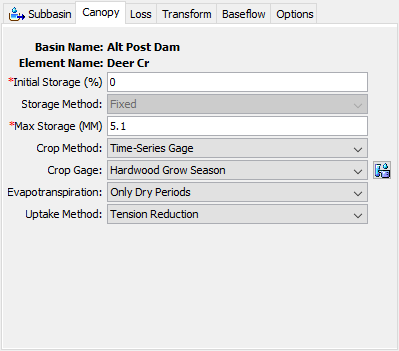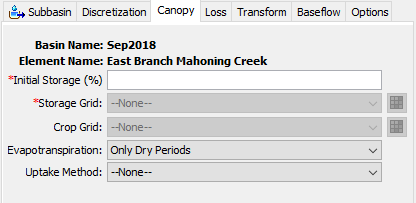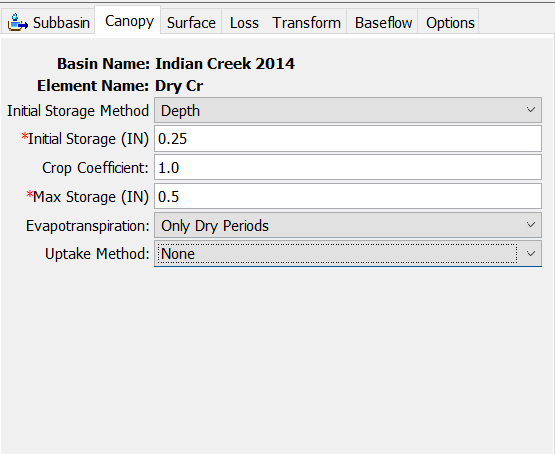Download PDF
Download page Selecting a Canopy Method.
Selecting a Canopy Method
The Canopy is one of the components that can be included in the Subbasin Element and can represent the presence of plants in the landscape. Plants intercept precipitation, reducing the amount of precipitation that arrives at the ground surface. Intercepted water evaporates between storm events. Plants also extract water from the soil in a process called transpiration. Evaporation and transpiration are often combined as evapo-transpiration. Selecting a Canopy Method is optional but should be used for continuous simulation applications.
The Canopy Method for a subbasin is selected on the Component Editor for the Subbasin Element as shown in the following figure. Access the Component Editor by clicking the Subbasin Element icon on the Components tab of the Watershed Explorer. You can also access the Component Editor by clicking on the element icon in the Basin Map, if the map is currently open. You can select a Canopy Method from the list of four available choices. If you choose the None method, the subbasin will not compute any interception or evapo-transpiration and all precipitation will be assumed as direct precipitation on the ground surface, and subject to interception by the surface, and infiltration into the soil. Use the selection list to choose the method you wish to use. Each subbasin may use a different method or several subbasins may use the same method.

When a new subbasin is created, it is automatically set to use the default Canopy Method specified in the Program Settings. You may change the Canopy Method for a subbasin at any time using the Component Editor for the Subbasin Element. Since a subbasin can only use one Canopy Method at a time, you will be warned when changing methods that the old parameter data will be lost. You can turn off this warning in the Program Settings. You can change the Canopy Method for several subbasins simultaneously. Click on the Parameters menu and select the Canopy Þ Change Method command. The Canopy Method you choose will be applied to the selected subbasins in the Basin Model, or to all subbasins if none are currently selected.
The parameters for each Canopy Method are presented on a separate Component Editor from the Subbasin Element editor. The Canopy editor is always shown next to the Subbasin editor. If the Kinematic Wave Transform Method is selected, there may be two Canopy editors, one for each runoff plane. The information shown on the canopy editor will depend on which method is currently selected.
Dynamic Canopy
This method includes an interception Storage Capacity and a Crop Coefficient that change in time. The storage capacity specifies the amount of water that can be held in the canopy before precipitation begins falling through to the ground surface. No through-fall will occur until the canopy storage is full. The canopy will use all potential evapo-transpiration until the storage is emptied. The potential evapotranspiration is multiplied by the crop coefficient to determine the amount of evapotranspiration from canopy storage and later the surface and soil components. Only after the canopy storage has been emptied will unused potential evapotranspiration be used by the surface and soil components. The Component Editor is shown below.

The initial condition of the canopy should be specified as the Percentage of the Canopy Storage that is full of water at the beginning of the simulation. There is currently only one method for specifying the storage capacity of the canopy. The storage is specified as a fixed effective depth of water that can be held in the canopy before additional precipitation falls through to the ground surface. The storage depth does not change for the duration of the simulation.
There are two methods for specifying the Crop Coefficient. A time-series may be used to specify how the crop coefficient changes during the plant growing season. The coefficient must be defined as a gage in the gage manager before it can be selected. You may use a chooser to select the gage by pressing the Gage button next to the selection list. You will not be able to select a gage if no gages have been created in the Time-Series Data Manager. Alternately, a grid may be used to specify how the crop coefficient changes at each grid cell during the growing season. The crop coefficient grid must be selected from the grids that have been previously defined in the Grid Data Manager.
The canopy can be set to only evaporate water from storage and extract water from the soil during dry time periods with no precipitation (Only Dry Periods). Version 4.1 of the program and all previous versions only performed evapotranspiration calculations during dry periods. Alternately, the canopy can be set to evaporate water from storage and extract water from the soil during both dry and wet periods (Wet and Dry Periods). The choice for simultaneous precipitation and evapotranspiration can improve results when using a long time interval or during a snowmelt simulation.
There are two methods for extraction of water from the soil. The Simple method extracts water at the potential evapo-transpiration rate, and can be used with the Deficit Constant or Soil Moisture Accounting Loss Rate Methods. The Tension Reduction method extracts water at the potential evapo-transpiration rate from the gravity zone but reduces the rate when extracting from the tension zone; it can only be used with the Soil Moisture Accounting Loss Rate Method.
Gridded Simple Canopy
This method implements the Simple Canopy Method on a grid cell basis. Each grid cell has separate parameter values, and separate precipitation. The Component Editor is shown below.

The initial condition of the canopy should be specified as the Percentage of the Canopy Storage that is full of water at the beginning of the simulation. The same percentage will be applied to every grid cell.
The Canopy Storage Grid must be selected from the grids that have been previously defined in the Grid Data Manager. The grid should specify the maximum canopy storage in each grid cell; the storage is constant for the duration of a simulation. You may use a chooser to select the grid by pressing the Grid button next to the selection list. You will not be able to select a grid if no grids have been created in the Grid Data Manager.
The Crop Coefficient Grid must be selected from the grids that have been previously defined in the Grid Data Manager. The grid should specify the ratio of the potential evapo-transpiration computed in the Meteorologic Model that should be applied in each grid cell; the coefficient is constant for the duration of a simulation. You may use a chooser to select the grid by pressing the Grid button next to the selection list. You will not be able to select a grid if no grids have been created in the Grid Data Manager.
The canopy can be set to only evaporate water from storage and extract water from the soil during dry time periods with no precipitation. Version 4.1 of the program and all previous versions only performed evapotranspiration calculations during dry periods. Alternately the canopy can be set to evaporate water from storage and extract water from the soil during both dry and wet periods. The choice for simultaneous precipitation and evapotranspiration can improve results when using a long time interval or during a snowmelt simulation.
There are two methods for extraction of water from the soil. The Simple method extracts water at the potential evapo-transpiration rate, and can be used with the Deficit Constant or Soil Moisture Accounting Loss Rate Methods. The Tension Reduction method extracts water at the potential evapo-transpiration rate from the gravity zone but reduces the rate when extracting from the tension zone; it can only be used with the Soil Moisture Accounting Loss Rate Method.
Simple Canopy
This method is a simple representation of a plant canopy. All precipitation is intercepted until the canopy storage capacity is filled. Once the storage is filled, all further precipitation falls to the surface, or directly to the soil if no representation of the surface is included. All potential evapotranspiration will be used to empty the canopy storage until the water in storage has been eliminated. The potential evapotranspiration is multiplied by the crop coefficient to determine the amount of evapotranspiration from canopy storage and later the surface and soil components. Only after the canopy storage has been emptied will unused potential evapotranspiration be used by the surface and soil components. The Component Editor is shown below.

The initial condition of the canopy can be specified as the Percentage of the Canopy Storage that is full of water at the beginning of the simulation, or as the depth of water in storage as an Initial Storage Depth.
Canopy Storage represents the maximum amount of water that can be held on leaves before through-fall to the surface begins. The amount of storage is specified as an effective depth of water.
The Crop Coefficient is a ratio applied to the potential evapo-transpiration (computed in the Meteorologic Model) when computing the amount of water to actually extract from the soil.
The canopy can be set to only evaporate water from storage and extract water from the soil during dry time periods with no precipitation. Version 4.1 of the program and all previous versions only performed evapotranspiration calculations during dry periods. Alternately the canopy can be set to evaporate water from storage and extract water from the soil during both dry and wet periods. The choice for simultaneous precipitation and evapotranspiration can improve results when using a long time interval or during a snowmelt simulation.
There are two methods for extraction of water from the soil. The Simple method extracts water at the potential evapo-transpiration rate, and can be used with the Deficit Constant or Soil Moisture Accounting Loss Rate Methods. The Tension Reduction method can be used with the Soil Moisture Accounting Method and extracts water at the potential evapo-transpiration rate from the gravity zone but reduces the rate when extracting from the tension zone. No water is extracted from the soil unless the Simple or Tension Reduction method is selected.